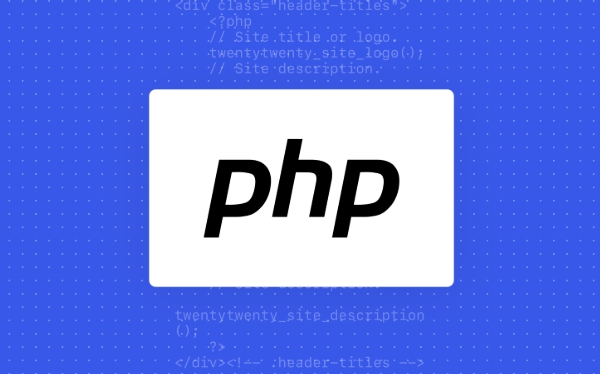 Backend Development
Backend Development
 PHP Tutorial
PHP Tutorial
 From Switch to Strategy: Decoupling Logic with Polymorphic Alternatives
From Switch to Strategy: Decoupling Logic with Polymorphic Alternatives
From Switch to Strategy: Decoupling Logic with Polymorphic Alternatives
Aug 02, 2025 am 06:40 AMWhen you see a switch statement based on type or state, it should be replaced with polymorphism to improve code quality. 1. Encapsulate behavior inside the object by defining the abstract base class Order and allowing each order type to implement its own process method. 2. The client code directly calls order.process() without conditional judgment. 3. When adding an order type, you only need to add a new class, without modifying the existing code, and it complies with the principle of opening and closing. 4. Switch can be retained in scenarios such as cross-sectional logic or external data processing, but should be considered for packaging using factory or policy mode. 5. For complex behaviors, a policy pattern can be introduced, the algorithm can be independently encapsulated and dynamically injected to achieve decoupling. Finally, we obtain a scalable, easy-to-maintain, and highly cohesive code structure.

When you're working in object-oriented programming, it's common to see code littered with switch statements or long chains of if-else conditions that branch based on an object's type or state. While this approach works, it often leads to tightly coupled, hard-to-maintain code. A better way? Replace those conditions with polymorphism—let objects decide their own behavior.

Why Switch Statements Become a Problem
Switch statements, especially those based on types or status codes, tend to spread throughout the codebase. Every time you add a new type or state, you have to hunt down every switch block and update it. This violates the Open/Closed Principle—software entities should be open for extension but closed for modification.
For example:

public void processOrder(Order order) {
switch (order.getType()) {
case STANDARD:
// handle standard
break;
case EXPEDITED:
// handle exposedited
break;
case RETURN:
// handle return
break;
}
}This logic is rigid. Add a new order type? You'll need to modify this method—and potentially others like it.
Polymorphism to the Rescue
Instead of asking an object what it is and then deciding what to do, let the object do the thing itself . This is the essence of polymorphism.

Start by defining a common interface or base class:
public abstract class Order {
public abstract void process();
}
public class StandardOrder extends Order {
public void process() {
// standard processing
}
}
public class ExpeditedOrder extends Order {
public void process() {
// exposed processing
}
}
public class ReturnOrder extends Order {
public void process() {
// return processing
}
}Now the client code becomes trivial:
public void processOrder(Order order) {
order.process(); // No switch needed
} The behavior is encapsulated within each type. Adding a new order type? Just implement the Order interface—no existing code needs to change.
Benefits of This Approach
- Extensibility : New types can be added without modifying existing logic.
- Maintainability : Each class handles its own behavior—single responsibility.
- Testability : You can test each implementation in isolation.
- Readability : The intent is clear—no mental mapping from enum to action.
When to Keep the Switch
There are cases where switch (or if-else ) still make sense:
- When the logic is truly cross-cutting or coordinating (eg, routing, logging, error handling).
- When you're working with external data (like JSON or API responses) where polymorphism isn't directly applicable.
- In languages with strong pattern matching (like modern Java or Kotlin), switches can be more expressive and safer.
But even then, consider encapsulating the dispatch logic in a factory or strategy registry.
Strategy Pattern: Taking It Further
For more complex cases, the Strategy Pattern formalizes this idea. You define a family of algorithms, encapsulate each one, and make them interchangeable.
public interface ShippingStrategy {
void ship(Order order);
}
public class StandardShipping implements ShippingStrategy { ... }
public class ExpressShipping implements ShippingStrategy { ... }
public class Order {
private ShippingStrategy shippingStrategy;
public void ship() {
shippingStrategy.ship(this);
}
}This decouples behavior from the core object and allow runtime selection.
Basically, whenever you see a switch on type or state, ask: Can this behavior live inside the object itself? If yes, let polymorphism handle it. The result is cleaner, more maintainable code that grows gracefully.
The above is the detailed content of From Switch to Strategy: Decoupling Logic with Polymorphic Alternatives. For more information, please follow other related articles on the PHP Chinese website!

Hot AI Tools

Undress AI Tool
Undress images for free

Undresser.AI Undress
AI-powered app for creating realistic nude photos

AI Clothes Remover
Online AI tool for removing clothes from photos.

Clothoff.io
AI clothes remover

Video Face Swap
Swap faces in any video effortlessly with our completely free AI face swap tool!

Hot Article

Hot Tools

Notepad++7.3.1
Easy-to-use and free code editor

SublimeText3 Chinese version
Chinese version, very easy to use

Zend Studio 13.0.1
Powerful PHP integrated development environment

Dreamweaver CS6
Visual web development tools

SublimeText3 Mac version
God-level code editing software (SublimeText3)

Hot Topics
 Unpacking Performance: The Truth About PHP Switch vs. if-else
Aug 02, 2025 pm 04:34 PM
Unpacking Performance: The Truth About PHP Switch vs. if-else
Aug 02, 2025 pm 04:34 PM
Switchcanbeslightlyfasterthanif-elsewhencomparingasinglevariableagainstmultiplescalarvalues,especiallywithmanycasesorcontiguousintegersduetopossiblejumptableoptimization;2.If-elseisevaluatedsequentiallyandbettersuitedforcomplexconditionsinvolvingdiff
 Refactoring God Switches: From Complex Conditionals to Clean Code
Aug 03, 2025 pm 04:01 PM
Refactoring God Switches: From Complex Conditionals to Clean Code
Aug 03, 2025 pm 04:01 PM
Use the policy pattern to replace complex conditional logic based on type or state with extensible policy classes; 2. Eliminate type checking through polymorphism, so that each object can realize its behavior by itself; 3. Replace simple value-to-value or value-to-action mapping with lookup tables (such as dictionaries); 4. Use guard clauses to return in advance to reduce nesting levels; 5. Extract methods to name and isolate conditional logic. These reconstruction methods convert complex conditional statements into clear and maintainable code, improve readability and scalability, and fully follow the principle of opening and closing, ultimately achieving a clean and expressive design.
 Mastering Control Flow: A Deep Dive into PHP's Switch Statement
Aug 01, 2025 am 07:42 AM
Mastering Control Flow: A Deep Dive into PHP's Switch Statement
Aug 01, 2025 am 07:42 AM
PHP's switch statement executes matching code blocks through expression evaluation and loose comparison, which is often used in multi-branch control processes; 1. Break must be used to prevent unexpected fall-through; 2. Switch uses loose comparison (==), which may lead to implicit conversion of types, and pay attention to type consistency; 3. You can intentionally implement logical merge of multiple cases by omitting break; 4. It is suitable for handling discrete value scenarios such as user roles and form actions; 5. The match expression introduced by PHP8 provides strict comparison and expression return, which is a safer modern alternative; 6. Simple mapping can be implemented with associative arrays combined with null merge operator; correctly using switch can improve generation
 From Switch to Strategy: Decoupling Logic with Polymorphic Alternatives
Aug 02, 2025 am 06:40 AM
From Switch to Strategy: Decoupling Logic with Polymorphic Alternatives
Aug 02, 2025 am 06:40 AM
When you see a switch statement based on type or state, it should be replaced with polymorphism to improve code quality. 1. Encapsulate the behavior inside the object by defining the abstract base class Order and allowing each order type to implement its own process method. 2. The client code directly calls order.process() without conditional judgment. 3. When adding an order type, you only need to add a new class, without modifying the existing code, and it complies with the principle of opening and closing. 4. Switch can be retained in scenarios such as cross-sectional logic or external data processing, but should be considered for packaging using factory or policy mode. 5. For complex behaviors, a policy pattern can be introduced, the algorithm can be independently encapsulated and dynamically injected to achieve decoupling. Finally, we can obtain a scalable, easy-to-maintain, and highly cohesive code structure
 Is Your PHP Switch a Code Smell? Identifying and Refactoring Anti-Patterns
Aug 02, 2025 am 08:00 AM
Is Your PHP Switch a Code Smell? Identifying and Refactoring Anti-Patterns
Aug 02, 2025 am 08:00 AM
Yes, the switch statement in PHP itself is not a code smell, but when it is repeated in multiple files, contains too many branches, is tightly coupled with business logic, violates the principle of single responsibility, or makes judgments based on object types, it becomes an anti-pattern; 1. Use policy mode processing factory: define processing interfaces and concrete classes, map types to processors through factory mapping, add new types only requires registration and no modification of existing code; 2. Use class-based distribution (polymorphism): let the object itself determine behavior, implement concrete logic by inheriting abstract classes, and directly execute methods when calling without switching; 3. Use closure mapping (suitable for simple scenarios): Use associative arrays to store the mapping of type to closures, avoid branch structure but are less testable; 4. PHP8 can be used
 Inside the Zend Engine: How PHP's Switch Statement Actually Works
Aug 03, 2025 am 12:55 AM
Inside the Zend Engine: How PHP's Switch Statement Actually Works
Aug 03, 2025 am 12:55 AM
TheswitchstatementinPHPisnotinherentlyfasterthanif-elseif;1)theZendEnginetypicallycompilesswitchintolinearlycheckedopcodes,resultinginO(n)performanceformostcases;2)onlysequentialintegercaseswithnogapsmaytriggerO(1)jumptableoptimization,butthisisrarea
 Boosting Readability: Best Practices for Writing Maintainable PHP Switch Blocks
Aug 04, 2025 pm 02:26 PM
Boosting Readability: Best Practices for Writing Maintainable PHP Switch Blocks
Aug 04, 2025 pm 02:26 PM
Keepcasesfocusedbydelegatingcomplexlogictodedicatedfunctions;2.Alwaysincludeadefaultcasetohandleunexpectedvaluessafely;3.Avoidfall-throughlogicunlessintentionalandclearlycommented;4.Usereturninsteadofbreakinfunctionstoreducevariableusageandenableearl
 Advanced PHP Switch Techniques You're Probably Not Using
Aug 04, 2025 am 05:45 AM
Advanced PHP Switch Techniques You're Probably Not Using
Aug 04, 2025 am 05:45 AM
Useswitch(true)forbooleanconditionstocreateacleanconditionalrouter.2.Combineswitchwithin_array()tohandlegroupedactionsefficiently.3.Enforcestricttypechecksusing===withinswitch(true)toavoidtypejuggling.4.Usecontinue2insideswitchwithinloopstoskiptothen





